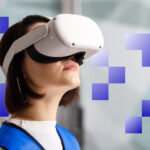The Easiest Ways to Experience Augmented Reality
In the past, the number of “augmented reality devices” available to users was limited. If you wanted to experience AR, you had to choose between downloading an app for your smartphone or spending a fortune on a headset with basic AR capabilities.
Now, however, the augmented reality market is growing – and the hardware sector is exploding. In fact, according to market reports, the hardware segment is the fastest-growing part of the AR market, with a CAGR of approximately 60.4%.
Despite this, many people (particularly enterprise users) have limited insight into how they can access augmented reality. That’s why we’ve created this guide to the easiest ways to bring AR into your day-to-day life, no matter how you plan on using immersive technology.
Understanding Augmented Reality Devices
You’re probably already familiar with the concept of “augmented reality.” Augmented Reality, or “AR,” refers to technology that blends digital information and images with the real world. It relies on both software and hardware.
Every type of AR experience relies on an augmented reality device, whether a smartphone or tablet with an integrated camera or a pair of AR glasses with built-in displays.
Augmented reality devices allow us to see the digital objects and information that AR apps “overlay” on top of real-world environments. AR relies on a few key components to create truly “immersive” experiences for users, such as:
- Input devices: These include the cameras and sensors used by apps to capture information about the real-world environment around you.
- Computer processors: Computing systems are necessary to process the data gathered by the input devices, allowing apps to track the location, orientation, and position of objects. Computer systems also allow AR devices to “render” 3D objects for AR displays.
- Output devices: The output devices are the tools, such as smartphones and smart glasses, that allow us to see the virtual objects created by AR in our real-world environments.
Types of Augmented Reality Devices: Your Options
In this guide, we’re discussing the easiest ways to experience augmented reality, so the devices we’ll focus on are “output” devices. If you wanted to create augmented reality experiences yourself, you’d also need input devices and software for creating AR apps (like Meta’s SDKs).
As mentioned above, the most common way to experience AR is on a mobile device. However, there are a few other options you can explore.
Smartphones and Tablets: The Simplest Option
Smartphones and tablets are by far the easiest (and probably least expensive) augmented reality devices. Virtually all of the top smartphones in the world today support augmented reality applications. According to one report, more than 90% of smartphones are AR-enabled. This means they support AR apps and have computing processors and input devices (like cameras) built-in.
The two biggest phone manufacturers in the world, Apple and Google, even offer creators access to developer kits to design their own AR content. Plus, most development tools for creating AR apps, like Unity and Unreal, support smartphone and tablet operating systems.
The great thing about smartphones and tablets is that they’re easily accessible. There are about 7.21 billion smartphones worldwide, for instance.
With an AR-enabled smartphone, all you need to do to experience AR is download an app and give it access to your camera. The apps you use will be able to process information about the world around you and show you images overlaid on top of your camera feed.
The Pros and Cons of Smartphones and Tablets
Smartphones and tablets are arguably the easiest and cheapest way to experience AR. Virtually anyone can access these tools without investing in additional hardware.
The trouble is, it’s not a fully “immersive” experience. You need to hold your smartphone up in front of you, and the experience you get will be limited based on the size of your screen, the app, and the computing power used.
Kiosk Systems, Large Displays, and AR Projectors
Technically, kiosk systems and larger augmented reality displays are just an “upgraded” version of the tablet or smartphone AR experience. You might have encountered a few of these displays and systems in the retail world already.
In 2012, Uniqlo (a clothing company) partnered with Holition to create the world’s first virtual fitting room. Since then, countless other retailers have introduced large-scale displays for fitting rooms that offer a similar experience. They allow users to virtually “try on” clothes or even experiment with different makeup options without having to physically interact with products.
Elsewhere, in the enterprise landscape, many AV vendors have been looking for ways to bring augmented reality into meeting experiences. For instance, there are projector systems that use both light projection tools and vision sensors to display interactive graphics in a specific environment.
For example, AR projectors can help teams understand how a product’s elements work in the manufacturing space. Or they could guide them through manufacturing, sequencing, assembly, and training tasks. In healthcare, AR projectors can enhance medical training and assist professionals during surgeries by overlaying images and information about vein systems and organs over a person’s body.
The Pros and Cons of Kiosk Systems, Displays, and Projectors
The great thing about these augmented reality devices is that they don’t require users to carry a device around. However, they can also be notoriously difficult to implement and extremely expensive.
These devices aren’t really intended for everyday end users—they’re more of a B2B-focused approach to AR experiences.
AR Glasses and Headsets: The Best Augmented Reality Devices
While smartphones, tablets, and even projection systems can all offer seamless augmented reality experiences, AR smart glasses and headsets are the gold standard for experiencing “immersive” augmented reality. Notably, there are various types of AR glasses and headsets.
Probably the most common option in the enterprise landscape are headsets which project specific information over a person’s vision. For instance, there are glasses that can provide access to real-time captions and translations, or specific text-based instructions, such as the Vuzix M400 specs.
In the consumer world, the most common AR glasses allow users to project a “virtual screen” in front of their vision. They’re usually connected to a smartphone, tablet, or laptop. For instance, with a pair of XReal Specs, you could watch a video on a virtual 200-inch screen.
Recently, companies in the XR landscape have been working on making AR glasses more immersive and intuitive too. For instance, Meta’s Prototype Orion glasses use custom eye-tracking, hand-tracking, and voice recognition software to allow users to interact with digital content in natural ways. There’s even a great EMG wristband with a built-in processor, for accurate finger tracking.
The Pros and Cons of AR Glasses
The great thing about smart glasses is they’re completely hands-free. They allow you to access content anywhere, on the move, without holding your phone up. As the AR glasses market grows, these augmented reality devices are becoming more accessible and affordable. Though there are expensive options out there, plenty of AR-powered specs cost less than $1,000. That makes them even cheaper than some cutting-edge VR headsets.
The biggest problem with these devices is they’re still a work in progress. Many glasses are still clunky and unattractive. Or they need to be constantly connected to an external device to work – because they don’t have built-in processors. Plus, the augmented reality experience on most glasses is still limited. You might see an image projected in front of you, but not all glasses will allow you to interact with content using gestures or eye movements.
Augmented Reality Devices: Emerging Options
Ultimately, the best ways to experience AR with augmented reality devices are through smartphones or tablets, projectors, kiosks, and large displays, or headsets and smart glasses. However, innovators are still experimenting with new potential options, such as:
- AR/VR headsets: AR/VR headsets are typically referred to as “mixed reality” devices, more than augmented reality devices. They allow users to choose the level of immersion they want, either diving completely into virtual reality, or overlaying content onto the real world around them with passthrough camera capabilities. The most obvious examples of these types of headsets include solutions like the Apple Vision Pro, or Meta Quest 3.
- AR Laptops: AR laptops are still a work in progress. Solutions like the Sightful Spacetop (recently canceled by Sightful) replace the screen on your laptop with a pair of augmented reality glasses. Those glasses are connected to the overall computer system. Other companies haven’t yet stepped up to introduce their own AR laptops – but there’s always a chance we could see more of these products in the years ahead.
- AR contact lenses: AR contact lenses are probably the least developed of all emerging augmented reality devices. We still don’t have any consumer-ready prototypes to explore – although various vendors have introduced concepts at world-leading events. For instance, in MWC 2024, the XPANCEO team generated hype with a selection of smart contact lenses, some of which had unique extended reality capabilities.
Getting Started with Augmented Reality Devices
The world of augmented reality devices has great potential to grow in the years ahead. For now, the easiest way to experience augmented reality is still through a smartphone or tablet. However, stick with smart glasses if you want a more immersive experience.
In the years ahead, we’ll undoubtedly see more advanced augmented reality glasses emerge. However, vendors could introduce us to a wider selection of hardware options, too, covering everything from AR laptops to contact lenses.
Quelle:



